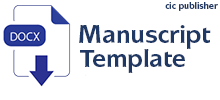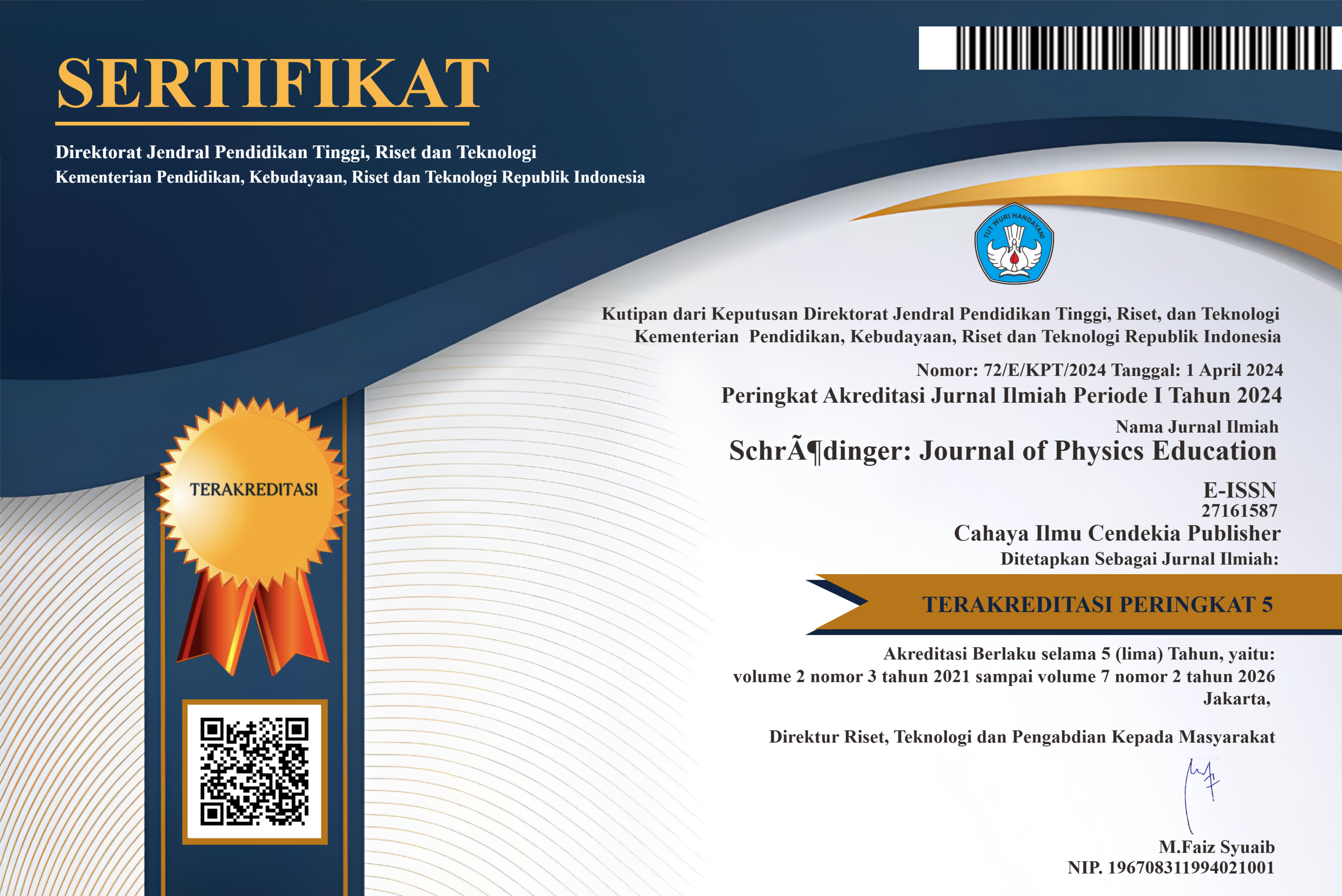Descriptive Study: Student Learning Motivation in Learning Physics of Renewable Energy Materials
Abstract
Purpose of the study: This research aims to describe student motivation in learning physics about renewable energy materials.
Methodology: This type of research uses descriptive research with the data used being quantitative. Data collection used a physics learning motivation questionnaire instrument for students. The sampling technique in this study used purposive sampling with a total sample in this study of 60 high school students. Data analysis used descriptive statistics assisted by SPSS.
Main Findings: Based on the results of student motivation questionnaire data obtained from Jambi City 2 High School and Triam Udom Suksa School, there were 60 respondents, namely an average score of 73.80. Next, the middle value (median) is 73. Then the minimum value is 56. And the maximum value is 94. The implication of this research is that by using a comprehensive and nuanced approach, this research aims to explain the factors that influence student motivation in certain academic domains. This investigation examines various elements such as curriculum design, teaching methodology, and the relevance of renewable energy materials in the learning process.
Novelty/Originality of this study: The novelty of this research is that the descriptive study pioneers exploration into the previously uncharted area of student learning motivation in physics, specifically focusing on the renewable energy materials domain. This research can be a means to improve physics teaching in the classroom
References
A. Astalini, D. A. Kurniawan, and S. Sumaryanti, “Sikap Siswa Terhadap Pelajaran Fisika di SMAN Kabupaten Batanghari,” JIPF (Jurnal Ilmu Pendidik. Fis., 2018, doi: 10.26737/jipf.v3i2.694.
S. N. Fadlilah, “Analisis Peningkatan Hasil Belajar Peserta Didik Pada Mata Pelajaran IPS Tentang Dokumen Pribadi Melalui Metode Index Card Match,” J. Soc. Knowl. Educ., vol. 3, no. 3, pp. 54–58, 2022, doi: 10.37251/jske.v3i3.409.
H. D. Saputro, M. A. Rustaminezhad, A. A. Amosa, and Z. Jamebozorg, “Development of E-Learning Media Using Adobe Flash Program in a Contextual Learning Model to Improve Students ’ Learning Outcomes in Junior High School Geographical Research Steps Materials,” J. Educ. Technol. Learn. Creat., vol. 1, no. 1, pp. 25–32, 2023, doi: 10.37251/jetlc.v1i1.621.
Kamid, D. A. Kurniawan, R. Perdana, B. Widodi, E. Triani, and P. Fadillah, “The Persistence Character and Math Processing Skills of Elementary School Students in Thematic Learning,” J. Ilm. Sekol. Dasar, vol. 7, no. 2, pp. 363–373, 2023.
Astalini, Darmaji, D. A. Kurniawan, S. W. Oktavia, E. Triani, and M. Z. Azzahra, “The Exploration of Character Values in Physics Learning on Momentum, Impulse, and Collision Materials,” J. Educ. Res. Eval., vol. 7, no. 2, pp. 277–284, 2023, doi: 10.23887/jere.v7i2.52381.
N. Nursyamsiah, “Minat Belajar dan Kemandirian Belajar Siswa terhadap Kreativitas Belajar Sejarah Siswa Kelas X IPS MAN 1 Kabupaten Sarolangun,” Indones. J. Educ. Res., vol. 3, no. 3, pp. 57–61, 2022, doi: 10.37251/ijoer.v3i3.562.
S. Raibowo, Y. E. Nopiyanto, and M. K. Muna, “Pemahaman Guru PJOK Tentang Standar Kompetensi Profesional,” J. Sport Educ., vol. 2, no. 1, p. 10, 2019, doi: 10.31258/jope.2.1.10-15.
F. R. Winda and R. Firmansyah, “Pengaruh Kegemaran Membaca Saintifik Terhadap Sikap Terhadap IPA di Sekolah Menengah Pertama,” vol. 2, no. 2, pp. 73–81, 2021, doi: 10.37251/jee.v2i2.155.
N. Hamidi, “Pengembangan Media Pembelajaran Interaktif Pendidikan Agama Islam Berbasis Adobe Flash Professional Cs6 Untuk Mendukung Implementasi Kurikulum 2013,” J. Pendidik. Agama Islam, vol. 14, no. 1, pp. 109–130, 2018, doi: 10.14421/jpai.2017.141-07.
C. J. Fitzgerald and S. Laurian-Fitzgerald, “Helping Students Enhance Their Grit and Growth Mindsets,” Journal Plus Education / Educatia Plus, vol. 14, no. Special Issue. pp. 52–67, 2016.
M. Aizinsh, S. W. Oktavia, R. Firmansyah, and Ruttinawati, “EXPLORATIONOF THE CHARACTER OF COOPERATION IN PHYSICS,” EduFisika J. Pendidik. Fis., vol. 8, no. 2, pp. 139–147, 2023, doi: 10.59052/edufisika.v8i2.26526.
A. Astalini et al., “Motivation and Attitude of Students on Physics Subject in the Middle School in Indonesia,” Int. Educ. Stud., vol. 12, no. 9, p. 15, 2019, doi: 10.5539/ies.v12n9p15.
S. W. Octavia, N. Septiani, F. Sinaga, and N. N. Qoidah, “ANALYSIS OF THE RELATIONSHIP IN LEARNING INTEREST TO LEARNING OUTCOMES STATIC FLUID MATERIAL IN SENIOR HIGH SCHOOL,” J. Ilm. Ilmu Terap. Univ. Jambi, vol. 87, no. 1,2, pp. 149–200, 2023.
J. P. Casquilho, F. Sinaga, N. Septiani, S. W. Oktavia, N. N. Qoidah, and E. F. S. Rini, “Pengaruh Kemampuan Berpikir Kritis Terhadap Hasil Belajar IPA Siswa,” EduFisika J. Pendidik. Fis., vol. 8, no. 2, 2023.
S. M. Haas, M. E. Irr, N. A. Jennings, and L. M. Wagner, “Communicating thin: A grounded model of online negative enabling support groups in the pro-anorexia movement,” New Media Soc., vol. 13, no. 1, pp. 40–57, 2011, doi: 10.1177/1461444810363910.
Astalini et al., “Identification of Student Character Values in Class X Particle Dynamics Materials,” JIPF (Jurnal Ilmu Pendidik. Fis., vol. 8, no. 3, pp. 380–388, 2023.
D. Fortus and I. Touitou, “Changes to students’ motivation to learn science,” Discip. Interdiscip. Sci. Educ. Res., vol. 3, no. 1, pp. 1–14, 2021, doi: 10.1186/s43031-020-00029-0.
S. Karuku, “Systematic Literature Review: Analysis of the Use of Website-Based Physics Learning Devices to Support Students’ Abilities in Learning Physics in High Schools,” J. Eval. Educ., vol. 4, no. 3, pp. 80–87, 2023, doi: 10.37251/jee.v4i3.336.
R. Irmayanti, M. Rusdi, and Y. Yusnaidar, “The Rasch Model: Implementation of Physics Learning Evaluation Instrument Based on Higher Order Thinking Skills,” Integr. Sci. Educ. J., vol. 4, no. 2, pp. 62–68, 2023, doi: 10.37251/isej.v4i2.325.
L. Bao and K. Koenig, “Physics education research for 21st century learning,” Discip. Interdiscip. Sci. Educ. Res., vol. 1, no. 1, pp. 1–12, 2019, doi: 10.1186/s43031-019-0007-8.
R. Afrizon, Hidayati, L. Dwiridal, and N. Khaira, “Optimizing the Use of Physics KITs that are integrated with the Scientific Context and Its Impact for Physics Teachers,” J. Penelit. Pendidik. IPA, vol. 7, no. 4, 2021, doi: 10.29303/jppipa.v7i4.1042.
Mirawati and W. Sukarni, “Description of Student Attitudes : Enjoyment in Learning Physics and Interest in More Time Studying Physics,” SchrödingerJournal Phys. Educ., vol. 4, no. 1, pp. 1–6, 2023, doi: 10.37251/sjpe.v4i1.490.
R. Azizah, L. Yuliati, and E. Latifah, “Kesulitan Pemecahan Masalah Fisika pada Siswa SMA,” J. Penelit. Fis. dan Apl., vol. 5, no. 2, pp. 44–50, 2015.
A. Romero, A. Santiago, and H. Bermúdez, “Motivation and Feelings of Competence Among University Students in Introductory Physics,” Res. Sci. Educ., vol. 53, no. 3, pp. 559–576, 2023, doi: 10.1007/s11165-022-10073-7.
N. Sari, W. Sunarno, and Sarwanto, “The Analysis of Students Learning Motivation on Physics Learn- Ing in Senior Secondary School,” J. Pendidik. dan Kebud., vol. 3, no. 1, pp. 17–32, 2018.
G. M. Assante and M. Momanu, “The role of critical motivation in the development of altruistic behaviour in youth,” J. Educ. Sci., vol. 1, no. 43, pp. 33–43, 2021, doi: 10.35923/JES.2021.1.03.
Copyright (c) 2023 Nuning Tri Handayani, Thanat Krobthong, Kaulu Goodwell

This work is licensed under a Creative Commons Attribution-NonCommercial 4.0 International License.
Authors who publish with this journal agree to the following terms:
- Authors retain copyright and acknowledge that the Schrödinger: Journal of Physics Education is the first publisher licensed under a Creative Commons Attribution 4.0 International License.
- Authors are able to enter into separate, additional contractual arrangements for the non-exclusive distribution of the journal's published version of the work (e.g., post it to an institutional repository or publish it in a book), with an acknowledgment of its initial publication in this journal.
- Authors are permitted and encouraged to post their work online (e.g., in institutional repositories or on their website) prior to and during the submission process, as it can lead to productive exchanges and earlier and greater citation of published work.






.png)
.png)








.png)
.png)
.png)







